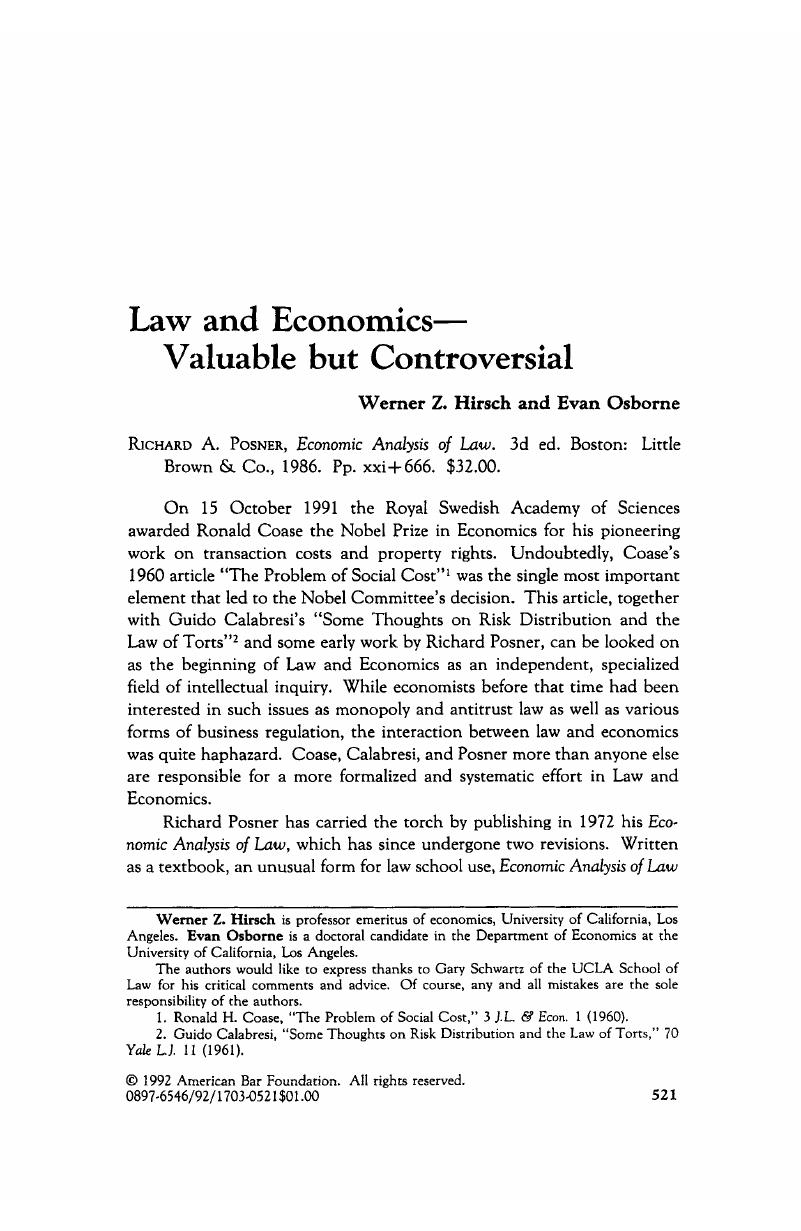Article contents
Law and Economics—Valuable but Controversial
Published online by Cambridge University Press: 27 December 2018
Abstract

- Type
- Review Essay
- Information
- Copyright
- Copyright © American Bar Foundation, 1992
References
1 Coase, Ronald H., “The Problem of Social Cost,” 3 J.L. & Econ 1 (1960).CrossRefGoogle Scholar
2 Calabresi, Guido, “Some Thoughts on Risk Distribution and the Law of Torts,” 70 Yale L.J 11 (1961).CrossRefGoogle Scholar
3 Coase, , 3 J.L. & Econ.Google Scholar
4 Coase, , 3 J.L. Law & Econ. (cited in note 1).Google Scholar
5 Hall v. City of Santa Barbara, 833 F.2d 1270 (9th Cir. Ct. App. 1986). This ruling is in conflict with one rendered more recently by a California appellate court in Yee v. City of Escondido, 224 Cal. App. 3d 1349 (Oct. 1990).Google Scholar
6 Azul Pacifico, Inc. v. City of Los Angeles, Daily Journal, DAR 13599 (1991).Google Scholar
7 The term used most often to refer to returns that exceed competitive returns is a “rent,” but to avoid confusion with the more conventional meaning of that term, for example, that used in the discussion of rent control laws, here the term “profits” is used to stand for “economic profits.” All these terms imply that there is an asset that bears a rate of return higher than that which would prevail under competitive conditions.Google Scholar
8 Such an appreciation in the value of a coach results when rent control laws lower rental rates below market levels and thus provide coach owners with a windfall in the form of capitalized lower rent payments in the future.Google Scholar
9 Hall v. City of Santa Barbara, 833 F.2d.Google Scholar
10 Hirsch, Werner Z., “An Inquiry into the Effects of Mobile Home Park Rent Control,” 24 J. Urban Econ 212 (1988).CrossRefGoogle Scholar
11 Becker, Gary, “Crime and Punishment: An Economic Approach,” 76 J. Pol. Econ 169 (1969).CrossRefGoogle Scholar
12 Brown, J. P., “Toward an Economic Theory of Liability,” 2 J. Legal Stud 323 (1973).CrossRefGoogle Scholar
13 Shavell, Steven, “Strict Liability versus Negligence,” 71 J. Legal Stud 1 (1980).CrossRefGoogle Scholar
14 Horvitz, Sigmund A. & Stern, Louis H., “Liability Rules and the Selection of a Socially Optimal Production Technology,” 7 Int'l Rev. L. & Econ 121 (1987).CrossRefGoogle Scholar
15 Cohen, Mark A., “Optimal Enforcement of Strategy to Prevent Oil Spills: An Application of a Principal-Agent Model with Moral Hazard,” 30 J.L. & Econ 23 (1987).CrossRefGoogle Scholar
16 Werner Z. Hirsch, Law and Economics 183 (2d ed. Boston: Academic Press, 1988) (“Hirsch, Law and Economics”).Google Scholar
17 Schwartz, Gary, “The Myth of the Ford Pinto Case,” 43 Rutgers L. Rev 1013 (1991).Google Scholar
18 Hirsch, Law and Economics 4–9.Google Scholar
19 A. Mitchell Polinsky, An Introduction to Law and Economics 7–10 (Boston: Little, Brown & Co., 1989).Google Scholar
20 For a definition, see note 4.Google Scholar
21 See, e.g., James M. Buchanan, Robert D. Tollison, & Gordon Tullock, eds., Toward a Theory of the Rent-seeking Society (College Station: Texas A & M Press, 1980).Google Scholar
22 See, e.g., Becker, Gary, “A Theory of Competition among Pressure Groups for Political Influence,” 98 Q.J. Econ 371 (1983), as well as Buchanan, et al. just cited.CrossRefGoogle Scholar
23 Cooter, Robert D. & Rubinfeld, Daniel L., “Economic Analysis of Legal Disputes and Their Resolution,” 27 J. Econ. Literature 1067 (1989).Google Scholar
24 Schwartz, , 43 Rutgers L. Rev. (cited in note 17).Google Scholar
25 Coase, , 3 J.L & Econ. (cited in note 1).Google Scholar
- 1
- Cited by




